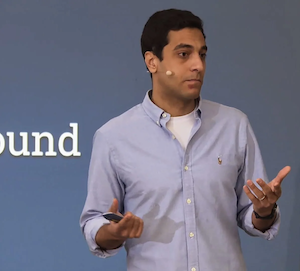 Today in healthcare, platforms are understood mostly as “technology”. That’s not wrong, but it’s limiting. We want to offer you a more expansive view of platforms, and in turn, understand platforms as being more than just technology. This post is the third in our series on The New Rules of Healthcare Platforms. In this essay, we will: Explain why platform business models are NOT new; Share a survey of health plan execs that documents a view of platforms as “technology”; Explain how network effects are the North Star of platform business models and strategy; Expand your view of platforms beyond just “technology.”
Today in healthcare, platforms are understood mostly as “technology”. That’s not wrong, but it’s limiting. We want to offer you a more expansive view of platforms, and in turn, understand platforms as being more than just technology. This post is the third in our series on The New Rules of Healthcare Platforms. In this essay, we will: Explain why platform business models are NOT new; Share a survey of health plan execs that documents a view of platforms as “technology”; Explain how network effects are the North Star of platform business models and strategy; Expand your view of platforms beyond just “technology.”
Feature Articles
The Emergence of Artificial Intelligence And Why Open Source Matters
 Sharing knowledge and sharing code has always been a key driver for innovation in Artificial Intelligence. Researchers have gathered together since AI was established as a field to develop and advance novel techniques, from Natural Language Processing to Artificial Neural Networks, from Machine Learning to Deep Learning. The Open Source community has played a key role in advancing AI and bringing it to solve real-world problems. Libraries and frameworks like TensorFlow, PyTorch, Keras, and Scikit-learn, for example, have allowed researchers and data scientists to study and make use of AI.
Sharing knowledge and sharing code has always been a key driver for innovation in Artificial Intelligence. Researchers have gathered together since AI was established as a field to develop and advance novel techniques, from Natural Language Processing to Artificial Neural Networks, from Machine Learning to Deep Learning. The Open Source community has played a key role in advancing AI and bringing it to solve real-world problems. Libraries and frameworks like TensorFlow, PyTorch, Keras, and Scikit-learn, for example, have allowed researchers and data scientists to study and make use of AI.
ONC HTI-1 NPRM Through Public Health Eyes
 On April 18, 2023, the Office of the National Coordinator for Health Information Technology (ONC) published for comment the Health Data, Technology, and Interoperability: Certification Program Updates, Algorithm Transparency, and Information Sharing (HTI-1) Proposed Rule which proposes new provisions from the 21st Century Cures Act and makes updates to the ONC Health IT Certification Program (Certification Program). Weighing in at over 500 pages (the pre-release version), this proposed rule provides some refinements to existing ONC programs, corrections to others, and extensions to yet other provisions. ONC provides additional materials about this proposed rule, including fact sheets, blog posts, and records from topical webinars on their website. Note especially the information provided about a joint ONC-CDC sponsored informational webinar which took place on May 24, 2023, and is available for playback on the site.
On April 18, 2023, the Office of the National Coordinator for Health Information Technology (ONC) published for comment the Health Data, Technology, and Interoperability: Certification Program Updates, Algorithm Transparency, and Information Sharing (HTI-1) Proposed Rule which proposes new provisions from the 21st Century Cures Act and makes updates to the ONC Health IT Certification Program (Certification Program). Weighing in at over 500 pages (the pre-release version), this proposed rule provides some refinements to existing ONC programs, corrections to others, and extensions to yet other provisions. ONC provides additional materials about this proposed rule, including fact sheets, blog posts, and records from topical webinars on their website. Note especially the information provided about a joint ONC-CDC sponsored informational webinar which took place on May 24, 2023, and is available for playback on the site.
The New Rules of Healthcare Platforms (Part 4): APIs Enable the Platforming of Healthcare
 Recent regulations have mandated the use of HL7 FHIR APIs (application programming interfaces) to share health data. The regs apply to healthcare providers, payers, and technology developers who participate in federal programs. Many incumbent healthcare organizations are viewing these mandates as a compliance burden. That’s short-sighted. We recommend a more opportunistic POV. APIs facilitate the sharing of health data across different devices and platforms. By adopting APIs, healthcare organizations can transform themselves from traditional service providers into powerful platforms that can connect patients, providers, and other stakeholders in new and innovative ways.
Recent regulations have mandated the use of HL7 FHIR APIs (application programming interfaces) to share health data. The regs apply to healthcare providers, payers, and technology developers who participate in federal programs. Many incumbent healthcare organizations are viewing these mandates as a compliance burden. That’s short-sighted. We recommend a more opportunistic POV. APIs facilitate the sharing of health data across different devices and platforms. By adopting APIs, healthcare organizations can transform themselves from traditional service providers into powerful platforms that can connect patients, providers, and other stakeholders in new and innovative ways.
The Cyber Resilience Act Introduces Uncertainty And Risk Leaving Open Source Projects
 What might happen if the uncertainty persists around who is held responsible under the Cyber Resilience Act (CRA)? The global Open Source community is averse to legal risks and generally lacks access to counsel, so it’s very possible offers of source code will simply be withdrawn rather than seeking to resolve the uncertainty. The CRA rightly addresses the need for commercial suppliers to protect their customers from exploits and cyber attacks. But legislators have exposed the open development of software itself to the regulations rather than just the for-profit use of Open Source artifacts in the marketplace. They are incorrectly assuming that Dirk Riehle’s terminology calling single-company projects “commercial Open Source” means it’s possible to use the “commerciality” of an application to distinguish single-company activity from community projects, and by using the concepts of proprietary software to then define boundaries.
What might happen if the uncertainty persists around who is held responsible under the Cyber Resilience Act (CRA)? The global Open Source community is averse to legal risks and generally lacks access to counsel, so it’s very possible offers of source code will simply be withdrawn rather than seeking to resolve the uncertainty. The CRA rightly addresses the need for commercial suppliers to protect their customers from exploits and cyber attacks. But legislators have exposed the open development of software itself to the regulations rather than just the for-profit use of Open Source artifacts in the marketplace. They are incorrectly assuming that Dirk Riehle’s terminology calling single-company projects “commercial Open Source” means it’s possible to use the “commerciality” of an application to distinguish single-company activity from community projects, and by using the concepts of proprietary software to then define boundaries.
ASTHO Releases Two New Reports On IIS
 In March 2023 the Association of State and Territorial Health Officers (ASTHO) released two environmental scans related to public health data and systems funded by a grant from ONC. The first report, Immunization Information Systems, and Health Information Exchanges: An Environmental Scan of Factors Influencing Data Sharing and Opportunities to Advance Population Health, provides a review of the state of both IIS and HIEs – as well as their points of intersection and support – especially as they were affected by the COVID-19 pandemic. ASTHO used a mixture of secondary source review (including our white paper on this topic from nearly ten years ago) and current interviews and focus groups to inform us about this complex and fluid topic.
In March 2023 the Association of State and Territorial Health Officers (ASTHO) released two environmental scans related to public health data and systems funded by a grant from ONC. The first report, Immunization Information Systems, and Health Information Exchanges: An Environmental Scan of Factors Influencing Data Sharing and Opportunities to Advance Population Health, provides a review of the state of both IIS and HIEs – as well as their points of intersection and support – especially as they were affected by the COVID-19 pandemic. ASTHO used a mixture of secondary source review (including our white paper on this topic from nearly ten years ago) and current interviews and focus groups to inform us about this complex and fluid topic.
3 Key Open Source Challenges in Developing Countries
 When I go back home and talk to people in the tech industry, or any other industry for that matter, about what I do and the topics I'm involved in daily, I'm usually met with bemusement at the idea of an Open Source Programs Office (OSPO). The concept of a company contributing to an open source project without obvious immediate financial benefit can be culturally strange to understand or explain. As someone born and raised in a country that has been trying to develop for quite some time, I understand and relate to that. There was a point in time when my only understanding of open source was that it was software that I could use without paying and without needing to wait for a specific issue or additional feature to be released. I could just do whatever I needed myself, locally. Open source faces many struggles in developing countries that make how it's perceived and its associations inaccurate and out of touch. I will discuss these struggles in this article.
When I go back home and talk to people in the tech industry, or any other industry for that matter, about what I do and the topics I'm involved in daily, I'm usually met with bemusement at the idea of an Open Source Programs Office (OSPO). The concept of a company contributing to an open source project without obvious immediate financial benefit can be culturally strange to understand or explain. As someone born and raised in a country that has been trying to develop for quite some time, I understand and relate to that. There was a point in time when my only understanding of open source was that it was software that I could use without paying and without needing to wait for a specific issue or additional feature to be released. I could just do whatever I needed myself, locally. Open source faces many struggles in developing countries that make how it's perceived and its associations inaccurate and out of touch. I will discuss these struggles in this article.
Two New Federal Reports Released That Have Major Public Health Impacts
 Two new Federal reports were recently released that have a public health impact. First, the Office of the National Coordinator for Health Information Technology (ONC) released its 2022 Report to Congress: Update on Access, Exchange, and Use of Electronic Health Information. This report covers the current state of adoption of health information technology and access to electronic health information guided largely by the requirements of the 2016 21st Century Cures Act. The report observes that, “Although tremendous progress has been made with EHRs that capture and support the use of health information about individuals, the COVID-19 pandemic exposed gaps in health IT systems that support capturing and using population data. The challenges exposed during the public health response to the COVID-19 pandemic pinpointed the importance of health IT to monitor population health regarding public health surveillance of testing, diagnosis, and vaccine distribution.”
Two new Federal reports were recently released that have a public health impact. First, the Office of the National Coordinator for Health Information Technology (ONC) released its 2022 Report to Congress: Update on Access, Exchange, and Use of Electronic Health Information. This report covers the current state of adoption of health information technology and access to electronic health information guided largely by the requirements of the 2016 21st Century Cures Act. The report observes that, “Although tremendous progress has been made with EHRs that capture and support the use of health information about individuals, the COVID-19 pandemic exposed gaps in health IT systems that support capturing and using population data. The challenges exposed during the public health response to the COVID-19 pandemic pinpointed the importance of health IT to monitor population health regarding public health surveillance of testing, diagnosis, and vaccine distribution.”
A Whirlwind Tour Of All The Connected Sites That Form The World Of Open Source Social Networks
 People want to communicate over the internet as easily as they do in real life, with similar protections but, potentially, farther reach. In other words, people want to be able to chat with a group of other people who aren't physically in the same location, and still maintain some control over who claims ownership of the conversation. In today's world, of course, a lot of companies have a lot to say about who owns the data you send back and forth over the world wide web. Most companies seem to feel they have the right to govern the way you communicate, how many people your message reaches, and so on. Open source, luckily, doesn't need to own your social life, and so appropriately it's open source developers who are delivering a social network that belongs, first and foremost, to you.
People want to communicate over the internet as easily as they do in real life, with similar protections but, potentially, farther reach. In other words, people want to be able to chat with a group of other people who aren't physically in the same location, and still maintain some control over who claims ownership of the conversation. In today's world, of course, a lot of companies have a lot to say about who owns the data you send back and forth over the world wide web. Most companies seem to feel they have the right to govern the way you communicate, how many people your message reaches, and so on. Open source, luckily, doesn't need to own your social life, and so appropriately it's open source developers who are delivering a social network that belongs, first and foremost, to you.
New Study Shows Patients Prefer Immediate Access to Test Results and have Unmet Information Needs
 A recent study of 8,000 patients that accessed their test results via an online patient portal found that more than 95% wanted to continue to immediately receive test results through their portal. That percentage stayed at 95% when focused on patients with non-normal results. These findings come amid concerns that the immediate release of test results could lead to patient distress when patients access test results before their physicians could contact them and help to interpret those results...since the ONC information blocking regulations became applicable to health care providers on April 5, 2021, a patient may be able to access test results in parallel to those results’ availability to the ordering clinician.
A recent study of 8,000 patients that accessed their test results via an online patient portal found that more than 95% wanted to continue to immediately receive test results through their portal. That percentage stayed at 95% when focused on patients with non-normal results. These findings come amid concerns that the immediate release of test results could lead to patient distress when patients access test results before their physicians could contact them and help to interpret those results...since the ONC information blocking regulations became applicable to health care providers on April 5, 2021, a patient may be able to access test results in parallel to those results’ availability to the ordering clinician.
Let's Do Public Health Better
 Eric Reinhart, who describes himself as “a political anthropologist, psychoanalyst, and physician,” has had a busy month. He started with an essay in the New England Journal of Medicine (NEJM) about “reconstructive justice,” then an op-ed in The New York Times on how our health care system is demoralizing the physicians who work in it, and then the two that caught my attention: companion pieces in The Nation and Stat News about reforming our public health “system” from a physician-driven one to a true community health one. He's preaching to my choir. I wrote almost five years ago: “We need to stop viewing public health as a boring, not glamorous, small part of our healthcare system, but, rather, as the bedrock of it, and of our health.” Dr. Reinhart pulls no punches about our public health system(s), or the people who lead them...
Eric Reinhart, who describes himself as “a political anthropologist, psychoanalyst, and physician,” has had a busy month. He started with an essay in the New England Journal of Medicine (NEJM) about “reconstructive justice,” then an op-ed in The New York Times on how our health care system is demoralizing the physicians who work in it, and then the two that caught my attention: companion pieces in The Nation and Stat News about reforming our public health “system” from a physician-driven one to a true community health one. He's preaching to my choir. I wrote almost five years ago: “We need to stop viewing public health as a boring, not glamorous, small part of our healthcare system, but, rather, as the bedrock of it, and of our health.” Dr. Reinhart pulls no punches about our public health system(s), or the people who lead them...
How Upstream Contributions Power Scientific Research
 Just as with software development, research under Horizon Europe promotes the adoption of sharing research outputs as early and widely as possible to citizen science, developing new indicators for evaluation research, and rewarding researchers. Horizon Europe emphasizes open science and open source technology. The program evolved from Horizon 2020, which provided financial support for research projects that promoted industrial competitiveness, advanced scientific excellence, or solved social challenges through the process of "open science." Open science is an approach to the scientific process based on open cooperative work, tools, and diffusing knowledge found in the Horizon Europe Regulation and Model Grant Agreement. This open science approach aligns with open source principles that provide a structure for such cooperation.
Just as with software development, research under Horizon Europe promotes the adoption of sharing research outputs as early and widely as possible to citizen science, developing new indicators for evaluation research, and rewarding researchers. Horizon Europe emphasizes open science and open source technology. The program evolved from Horizon 2020, which provided financial support for research projects that promoted industrial competitiveness, advanced scientific excellence, or solved social challenges through the process of "open science." Open science is an approach to the scientific process based on open cooperative work, tools, and diffusing knowledge found in the Horizon Europe Regulation and Model Grant Agreement. This open science approach aligns with open source principles that provide a structure for such cooperation.
Open Source Software Is Transforming Healthcare
 In the summer of 2022, the UK government and NHS England published its Open Source Policy, stating that open source technology is: Particularly suitable for use within the healthcare industry where, through active collaboration between IT suppliers and user/clinicians communities, solutions can be honed to maximise benefits to delivery of health and social care. The public statement by NHS England is just the latest development in a broader trend: The wholehearted embrace of open source software by the healthcare sector. And no wonder; open source presents myriad opportunities for this most complex of industries, with potential solutions across various sub-sectors. Yes, open source is now powering everything from medical wearables to healthcare human resource management.
In the summer of 2022, the UK government and NHS England published its Open Source Policy, stating that open source technology is: Particularly suitable for use within the healthcare industry where, through active collaboration between IT suppliers and user/clinicians communities, solutions can be honed to maximise benefits to delivery of health and social care. The public statement by NHS England is just the latest development in a broader trend: The wholehearted embrace of open source software by the healthcare sector. And no wonder; open source presents myriad opportunities for this most complex of industries, with potential solutions across various sub-sectors. Yes, open source is now powering everything from medical wearables to healthcare human resource management.
Some Barriers and Challenges to the CDC's Data Modernization Initiative
 As we have discussed in earlier posts, the Centers for Disease Control and Prevention (CDC) has launched a Data Modernization Initiative (DMI) focused on improving the data management capacity of public health in the United States. The major focus of this initiative is on investments in both people as well as systems and data to improve public health response. Though Congress has appropriated a significant amount of funding for Federal and state, territorial, local, and tribal (STLT) public health agencies, there are some sizable barriers and challenges to seeing the vision for DMI come to fruition:
As we have discussed in earlier posts, the Centers for Disease Control and Prevention (CDC) has launched a Data Modernization Initiative (DMI) focused on improving the data management capacity of public health in the United States. The major focus of this initiative is on investments in both people as well as systems and data to improve public health response. Though Congress has appropriated a significant amount of funding for Federal and state, territorial, local, and tribal (STLT) public health agencies, there are some sizable barriers and challenges to seeing the vision for DMI come to fruition:
The New Rules of Healthcare Platforms (Part 3): Platform Thinking Expands from “Technology” to Business Model & Strategy
A New Generation Of Tools For Open Source Vulnerability Management
 Product security incident response teams (PSIRTs) are teams of security professionals that work diligently behind the scenes to protect software products and services of companies. A PSIRT is a different breed than a computer security incident response team (CSIRT), those that tend to be called Information Security. The difference is simple but stark: a CSIRT focuses on responding to incidents that affect a company's infrastructure, data or users. A PSIRT focuses on responding to incidents that affect products a company builds, the most common being the discovery of a vulnerability or security defect, and subsequent actions to manage or remediate. Read More »
Product security incident response teams (PSIRTs) are teams of security professionals that work diligently behind the scenes to protect software products and services of companies. A PSIRT is a different breed than a computer security incident response team (CSIRT), those that tend to be called Information Security. The difference is simple but stark: a CSIRT focuses on responding to incidents that affect a company's infrastructure, data or users. A PSIRT focuses on responding to incidents that affect products a company builds, the most common being the discovery of a vulnerability or security defect, and subsequent actions to manage or remediate. Read More »